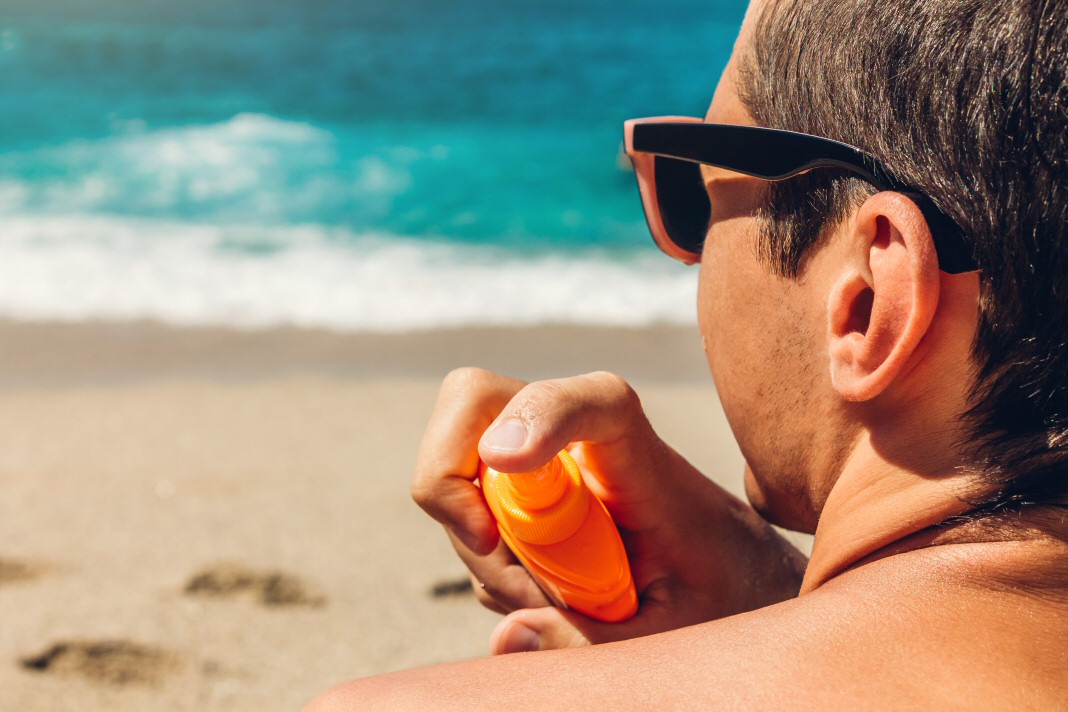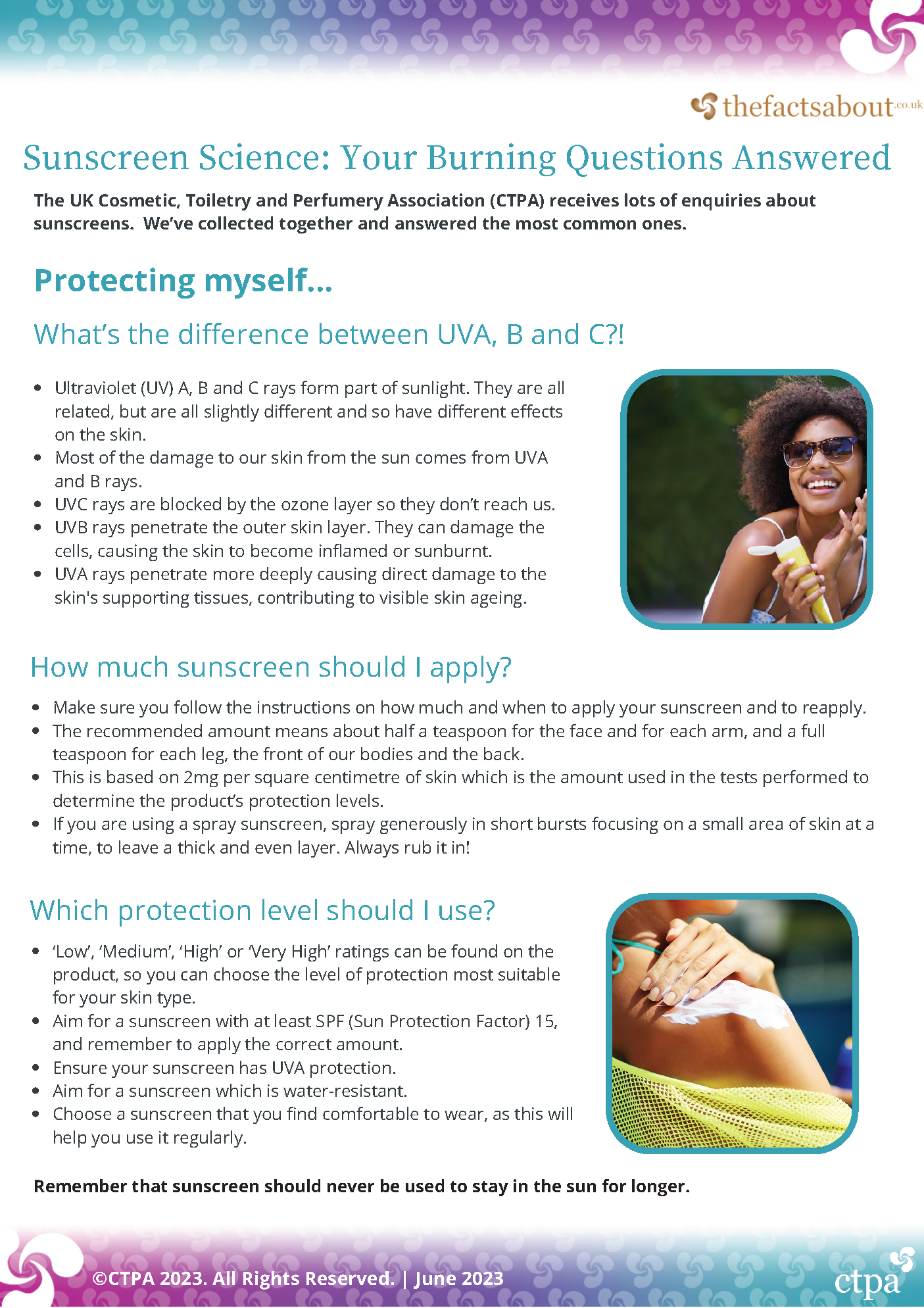In this section:
- Sunscreen Science! Your burning questions answered
- When should I apply sunscreen?
- How much sunscreen should I apply?
- Always follow the instructions
- Am I protected in water?
- What should I consider when going abroad to hot countries?
- Should I use sunscreen when skiing?
- Simple steps to stay sun safe
Sunscreen Science! Your burning questions answered
CTPA receives lots of enquiries about sunscreens. We’ve collected together – and answered – the most common ones, ahead of the holiday season. Download our factsheet to learn more!
The questions covered in this factsheet are:
- What’s the difference between UVA, B and C?
- How much sunscreen should I apply?
- Which protection level should I use?
- How long will my sunscreen last for?
- Can I just use a moisturiser with SPF?
- I have a darker skin tone, do I still need to use sunscreen?
- Will wearing sunscreen stop my body making vitamin D?
- Can sunscreen harm coral?
- Where can I find out more?
When should I apply sunscreen?
Sunscreen should be applied and allowed to dry on the skin 15-30 minutes before you go out in the sun, and then re-applied often (at least every 2 hours - or more frequently if washed, rubbed or sweated off). It is important to reapply sunscreen to maintain the expected level of protection.
However, sunscreens should never be used in order to stay in the sun for longer.
How much sunscreen should I apply?
Sunscreen is often labelled with instructions such as "apply generously" or "apply liberally". The recommended amount to be applied is based on 2mg/cm2 body surface area, the amount used in the scientific test to determine the product is effective. This is quite hard to visualise, but it can be more easily thought of as about 35ml for an average person or a "golf ball" size amount per body; or six to eight teaspoons.
 Distribute this evenly across your body, trying not to miss any areas. Think of applying a good teaspoonful for each arm, a little more than this for each leg and two more for your chest and back. Don't forget sneaky areas such as ears and under the chin, or the soles of the feet if you're going to be lying down with them exposed to the sun! These areas can burn very easily.
Distribute this evenly across your body, trying not to miss any areas. Think of applying a good teaspoonful for each arm, a little more than this for each leg and two more for your chest and back. Don't forget sneaky areas such as ears and under the chin, or the soles of the feet if you're going to be lying down with them exposed to the sun! These areas can burn very easily.
If you're not sure whether you've covered all of your skin, you might want to consider applying another layer of sunscreen to make sure you don't miss any patches. To use an analogy, when you are painting a wall, it often helps to add a second coat to ensure an even finish with no gaps!
Always follow the instructions
Make sure you follow the instructions on how much and when to apply your sunscreen and to reapply. Remember to make sure you rub your sunscreen over all of the areas that are going to be exposed to the sun.
Am I protected in water?
 UV rays can penetrate water to a depth of at least 10 metres when the sun is overhead. Remember that the cooling effect of the water may be deceptive and mask severe sunburn, which only becomes apparent after leaving the water. It is important to use a water-resistant sunscreen when swimming, particularly between 11.00am and 3.00pm. After swimming, even water-resistant sunscreens should be reapplied.
UV rays can penetrate water to a depth of at least 10 metres when the sun is overhead. Remember that the cooling effect of the water may be deceptive and mask severe sunburn, which only becomes apparent after leaving the water. It is important to use a water-resistant sunscreen when swimming, particularly between 11.00am and 3.00pm. After swimming, even water-resistant sunscreens should be reapplied.
What should I consider when going abroad to hot countries?
It is important to use a higher SPF when visiting hot countries. In the tropics, the season is always summer and the intensity of the midday sun is extremely high. When visiting, you should always use a sunscreen of at least SPF 30 and reapply frequently.
However, please remember that the burning power of the summer sun in the UK can be as great as in the Mediterranean and you should use sunscreen as part of your sun safe regime here in the UK too, choosing your SPF accordingly.
Should I use sunscreen when skiing?
It is important to protect yourself from the sun when skiing. Snow reflects up to 90% of UV rays and, in addition, UV ray increases by 20% for every 1000m above sea level. For this reason, sun protection is vital in snowy conditions. Even in winter, there is sufficient UVB at skiing heights to cause severe burning. As a consequence, full precautions against UV damage should be taken, including sunscreens, clothing and goggles.
Simple steps to stay sun safe
-
Seek out shade, particularly between 11am and 3pm, when the sun is usually at its most intense
-
Wear loose-fitting clothing and a wide-brimmed hat when in the sun and wear a good pair of sunglasses
-
Apply sunscreen 15-30 minutes before going out in the sun and re-apply every couple of hours throughout the day - you will need about a golf-ball-sized amount of cream for each application
-
Remember to re-apply when you emerge from cooling off in the water
-
Never use sunscreen to extend the time you would normally spend in the sun
-
Drink plenty of water, particularly in hot weather. Keeping your water intake up prevents dehydration and maintains a healthy bladder and kidneys; a healthy body helps to support healthy skin
Over-exposure to the sun is dangerous and can cause sunburn or heatstroke. Your skin will be hot, red, blistered, painful and swollen and you may have a severe headache or feelings of nausea. Get out of the sun, keep the skin cool, drink plenty of water and seek professional medical advice as soon as possible.


